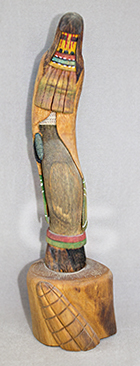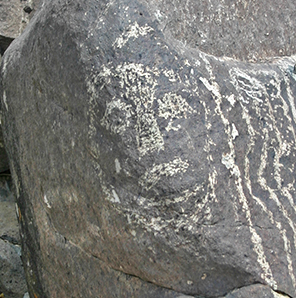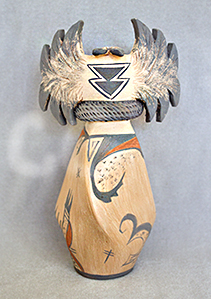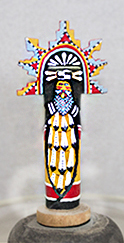
![]() Back to Native American Crafts Information Menu
Back to Native American Crafts Information Menu
The Kachina as Art
In “Kachina Images in American Art” J.J. Brody identifies two types of kachina images made for non-Natives—paintings and carvings. In the past, both were mainly produced by the Hopi.
Euro-American collection of kachinas started about 1850, but it wasn’t until 1920 that kachina images were considered an art form. Prior to that time they were regarded as souvenirs from trips to an exotic place or artifacts of Pueblo Indian culture.
When the Santa Fe Railroad brought visitors closer to a once remote area, crafts men at Hopi began making the dolls, originally called “tihu” for sale to outsiders. Thomas Keam, who in 1869 established a trading post near Hopi First Mesa, became a primary dealer in kachina carvings. Other traders followed suit.
Kachinas were sold to museums in the United States and Europe, as well as to private collectors. After about 1925, museums and juried arts and crafts fairs became important markets for kachina carvings and paintings. The Museum of Northern Arizona promoted kachina statuettes at it’s annual “Hopi Craft Exhibition”. As part of this exhibition, the museum set up a code of the aesthetic qualities it found desirable in kachina carvings as well as certifying authenticity of kachinas exhibited and sold there.
By the end of World War II, when paved roads made access to the Hopi mesas easier, kachina dolls became what Brody describes as a generic kind of southwestern souvenir.
Although paintings of kachinas on paper were commissioned as early as 1900, the first modern Hopi artist to paint kachina images of his own volition was Fred Kabotie, a young student at the Santa Fe Indian School. In 1918, he started painting watercolors of kachinas outside of school hours to express something from his home. He was joined by another Hopi, Otis Polelonema, and others, who formed their own art group. Both Kabotie and Polelonema continued to paint after graduation: Kabotie stayed in Santa Fe, Polelonema went home to teach art at Oraibi High School where his influence began a tradition of painting kachinas on paper.
Over the years kachina styles have changed due to demands of the market and other influences. Brody says that 19th century kachinas are usually “stiff, frontal, bilaterally symmetrical, and roughly detailed.” Dolls made in the early 20th century had lifelike head and body proportions and distinct legs and arms, and natural body poses. By the 1930s, kachina dolls came with pedestals, smooth surfaces and fine details.
In kachinas from the 1980s, paint was often replaced by washes through which the wood grain is visible; these kachinas can be very elongated with a head to body ratio of 10:1 or greater.
(Brody, J.J. “Kachina Images in American Art,” Kachinas in the Pueblo World, 1994, University of New Mexico Press)
 1980s elongated Pachavuin Mana kachina by Troy Quimayousie
1980s elongated Pachavuin Mana kachina by Troy Quimayousie
© 2017 LDE
Some of the quality kachinas made today are extremely lifelike, showing a human dancer portraying a kachina; parts or all of the kachina may be painted, and are sometimes polished. Kachina carvings and paintings are still bought as souvenirs, while higher priced, exquisitely crafted kachinas are displayed in galleries and crafts fairs for the collector. At the Santa Fe Indian Market it’s not unusual to see one of a kind kachinas priced at several thousand dollars.
What Is a Kachina?
The word “kachina,” believed to come from the Keresan* language, means clouds, storm clouds or cloud people. Although some pueblos, like Zuni, have a word for kachina in their own language, kachina is used by many pueblo tribes including Hopi and Jemez as well as Tewa** speaking pueblos. (Schaafsma, Polly (editor) Kachinas in the Pueblo World.
A kachina is a messenger from the gods, a spirit intermediary between gods and men who brings life-giving rain to an arid world, as well as fertility and healing. Depending on the pueblo, kachinas are the spirits of those now passed who become kachinas when they die, turning into rain clouds to bring blessings to their kin. A kachina can be the spiritual essence of an animal, a domestic plant, a bird, an abstract concept like death or the power of a neighboring tribe. (Schaafsma, Polly Rock Art in New Mexico 1992, Museum of New Mexico Press.) Kachinas are the masks created to portray the original kachinas who no longer come in person, but whose essence imbues the mask wearer during ritual dances.
Finally, to most of the non-Pueblo world, a kachina--sometimes spelled katsina or katchina--is a painted or carved image of these spirits.
The Kachina Cult
Some scholars believe that the kachina cult, found only among the Pueblo tribes in New Mexico and Arizona, developed spontaneously; other argue that the influence behind it came from Mesoamerica. To date there is no physical evidence of direct interaction between the Mimbres and Jornada Mogollon peoples and the Aztecs, but trade routes between the two areas had existed for centuries. The first archaeological evidence of images associated with Mesoamerican gods was found in the Mogollon region and dates from about 1000 CE. As with all exchanges between different cultures, it’s likely that ideas as well as material goods were traded.
The theory of a Mesoamerican origin of the kachina cult arises from shared ideology and symbols. Both cultures have—among other things--masked dances, highly developed sky and earth gods, divine twins and, the association of colors with specific directions. It’s symbols are masks and mask-like faces, war symbols such as shields, weapons, stars and eagles depicted in rock art, on pottery and later in kiva murals (Schaafsma, Polly Rock Art in New Mexico). Images of horned serpents and Tlaloc-like masks are found in Jornada Mogollon rock art. And, the Mogollon peoples had contact with pueblos to the north and west.
 Example of a Jornada Mogollon mask from Three Rivers Petroglyph Site
Example of a Jornada Mogollon mask from Three Rivers Petroglyph Site
© 2008 LDE
Whatever it’s origins, the kachina cult spread quickly; it was equally strong among the eastern pueblos along the Rio Grande River and in the mesas of western Arizona.
By about 1300 CE the kachina cult was practiced throughout the Pueblo world. Archaeologists have noted significant changes occurring at the same time: Anasazi pueblos were gradually abandoned while small settlements in the Little Colorado River basin of eastern Arizona and western New Mexico grew dramatically. As villages increased in size, large enclosed plazas were built within them; these plazas normally had kivas big enough to serve the increased population. (Adams, E. Charles “The Katsina Cult: A Western Pueblo Perspective,” Kachinas in the Pueblo World)
The kachina cult may have helped to integrate newcomers into the settlements by giving them a role in religion and society.
Historical records show that when the Spanish entered New Mexico, kachina dances were performed at all of the Rio Grande River pueblos as well as those in the west. The missionaries who came with and after the first explorers, saw the traditional religion as a form of idolatry and tried root it out by conversion and by destroying murals, altars, masks and other religious paraphernalia. To a certain extent they succeeded, but the dances were revived after the Pueblo Revolts, although they were usually kept secret from the dominant culture. (Schaafsma, Curtis F. “Pueblo Ceremonialism from the Perspective of Spanish Documents,” Kachinas in the Pueblo World) The San Estevan del Rey church in Sky City, built by the Acoma people at the order of the Spanish, was nevertheless decorated with symbols from traditional culture: parrots, rainbows and corn stalks.
Kachinas change. While some of the kachinas appearing in Pueblo dances today, like Ahőla, are the same as those from the past, new kachinas are continually appearing. The appearance and function of a kachina may vary from pueblo to pueblo, or change over time due to the impact of other cultures, epidemics or droughts. The physical appearance of Long Haired Kachinas are different at Hopi, at Zuni, Santa Ana, Cochiti and so on. (Wright, Barton “The Changing Kachina,” Kachinas in the Pueblo World)
Among the Zuni, carved dolls, called “we ha” or babies, are gifts given to young girls by the kachinas during kachina ceremonies and winter night dances. The doll is considered a spirit being, born of a female kachina in the afterworld, and must be treated with respect. Although the dolls are made by a member of the girl’s family, they’re part of Zuni religion and culture. (Ladd, Edmund J. “The Zuni Ceremonial System: The Kiva,” Kachinas in the Pueblo World) Ladd Zuni/Cherokee/Jicarilla Apache, said that the same custom exists among the Hopi, but the Hopi also make dolls for sale.
What to Look for in Kachinas
Kachinas can range in size from tiny miniatures less than an inch high, to over a foot high.
 Miniature Navajo-made kachinas about 1″ high
Miniature Navajo-made kachinas about 1″ high
© 2017 LDE
Materials. Traditionally, kachinas were made from cottonwood root. Most kachina dolls are still made of wood, although in recent years some artists have moved into new materials, like horn or clay.
Provenance. For anyone interested in more than a souvenir, authenticity is the most important thing when buying kachina dolls and paintings. Museums specializing in Native American culture, reputable galleries and crafts fairs are the best places to buy. Today many have on-line stores. As with all high quality Native American crafts, the artist’s name and tribe should be available, and, in many cases, a certificate of authenticity.
Paintings and good quality kachina dolls are usually signed by the artist, as are signed, numbered prints. Ask before buying.
 Clay Crow Mother kachina by Valerie Namoki
Clay Crow Mother kachina by Valerie Namoki
© 2017 LDE
Kachina Makers. It’s important to know that almost all of the kachina figures offered for sale are made for a non-Native market.
In the past most “for sale” kachina paintings and sculptures were made by Hopis. Today many kachinas are still made by Hopis; a few are made by Zunis. Navajos also make and sell kachinas. Navajos don’t practice the Kachina Cult although their belief system has been influenced by that of neighboring pueblos. Some Navajo kachinas are copies of pueblo kachinas, others are not kachinas, but figures from the artist’s own tribal culture, such as Navajo Yebechai dancers.
Craftsmanship. While there are hundreds of different kachinas and many styles of kachina dolls, craftsmanship is a primary consideration when buying. Since the doll will be a decoration or part of a collection, the skill of the artist who made it and the time and care put into the making should be considered. Many of today’s kachinas have costume details carved or painted on, but some include fabric, beads and feathers glued to the wooden figure. If some of these things are loose or falling off before purchase, more will probably come off later. Painted or carved details should be crisp and skillfully done. Ask the seller if you have questions.
*Keresan is the language spoken by the Keres people. Today the Keres pueblos include Laguna, Acoma, San Felipe, Cochiti, Kewa, Zia and Santa Ana.
**Tewa or Tano is the language spoken by the Tewa people. Today the Tewa pueblos include Pojoaque, Nambe, San Ildefonso, Okey Owingeh, Santa Clara and Tesuque, along with the community of Hano on the Hopi Reservation.
Much of the historical information in this article is taken from Kachinas in the Pueblo World, edited by Polly Schaafsma,1994 University of New Mexico Press. There is a newer edition published in 2000 for those who want to learn more about kachinas and pueblo religion.
This article represents contemporary theories on the origin and development of the Kachina Cult from a mostly non-Native point of view. The Native peoples whose religion and cultures are discussed above have their own traditions of how they came to be who they are and where they are.
 Navajo-made Shalako kachina
Navajo-made Shalako kachina
© 2017 LDE
This information is provided to help you in selecting and evaluating Native American jewelry and crafts.
We are happy to answer questions by email.
Please note that Coyote's Game does not buy or sell used or vintage kachinas, nor do we appraise Native American kachinas.
Email us at
© 1999-2025 Coyote's Game. Reproduction without permission is prohibited.
